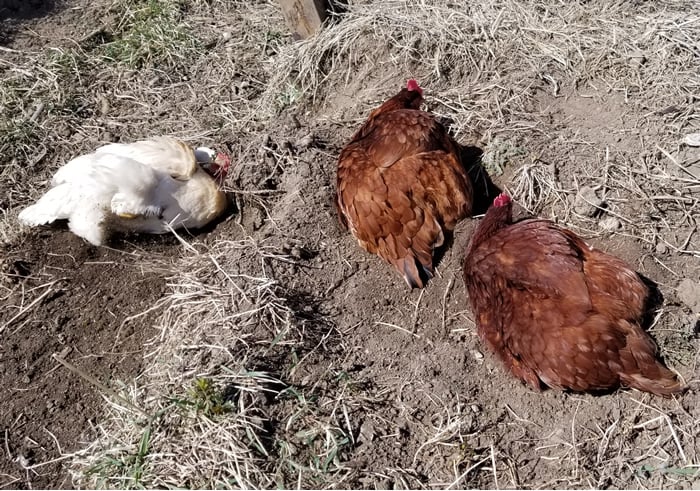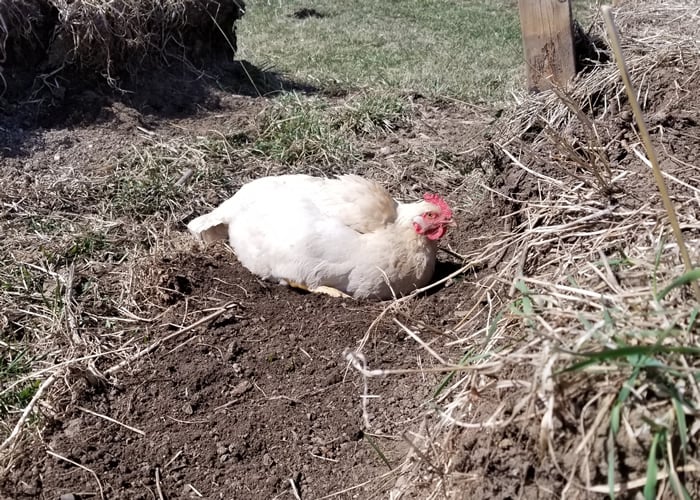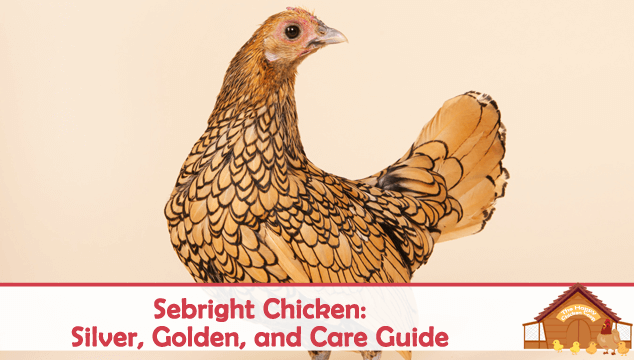Chickens do some crazy things– that’s why we love them, right? But what in the world are they doing when they are flopping around in the dirt, acting like a wounded animals?
What is My Chicken Doing?
If you’ve witnessed your chickens taking a dust bath, you may have thought they were injured or dying.
After a few moments of freaking out, you could tell they were intentionally taking a bath…in the dust.
What is a Dust Bath?
A dust bath is sort of what it sounds like. It’s when chickens take a spa day in the dirt.
They fluff up their feathers and find a place that has fine dirty. They flop, and roll, and kick at the soil to ensure it gets, well, everywhere on their bodies.
Usually, chickens have favorite locations for dust baths and will return to them when needed, and when conditions are right
Now, don’t confuse a dust bath with a mud bath…chickens like silty, dry, dirt that is usually out of reach of aerial predators. So, naturally, they will pursue your lovely landscaping for their dust baths.
Why Do Chickens Take Dust Baths
Chickens take dust baths for the same reasons humans bathe…well, for some of the same reasons.

1. To control oils on their bodies.
Chickens have oil glands that can get a little out of control.
They preen their feathers to distribute the oils on their bodies.
But, when they need to tame their oils, they take a dust bath to absorb some of the excess oil.
2. To get rid of mites and lice
Lice and mites are external parasites that can cause many problems for chickens including
- Itching
- Feather Loss
- Anemia
- Death
Luckily, chickens know how to prevent, and treat mild infestations, on their own.
Dust can suffocate, dry up, and kill these unwanted mites. There are also other diseases that can appear as the same symptoms so its always important to inspect your chickens for lice or mites as the root cause.
3. For pure enjoyment
This may be pure speculation on my part, but if you’ve ever witnessed a fat fluffy hen taking a dust bath, you know they are on cloud nine. Usually, they pick a sunny spot, safe from predators, and spend 15-20 minutes just rolling around in the dry dirt.
Their eyes are half-closed, their wings are relaxed, and they often bathe in a group.
Do Chickens Need to Take Dust Baths?
As you can see, chickens do need to take dust baths to be clean and happy. If you’ve ever had to keep chickens locked in their coop for a few days, and then released them, one of the first things they do is seek out an ideal dust bath location and get to work.
So, while chickens in commercial industries who are in hen houses, caged, or confined do not have access to dust bathes, they are more at risk for mites and lice.
Thus, they are usually medicated rather than being allowed to bathe themselves as they would in the wild naturally.
In other words, it’s polite to allow your chickens a space of their own for taking dust baths as they see fit.
How To Make A Dust Bath
Here’s the thing about chickens and dust bathes:
If you don’t provide one for them, they will make one. Even in confinement, your chickens will attempt to take dust bathes anywhere it is slightly dusty.
They just crave it! Instead of leaving your chickens up to their own devices, you can make an attractive dust bath that will keep them happy, clean, and out of your landscaping.
You can use dirt from around your yard, or use diatomaceous earth and get a double whammy dose of mite busting power. In general, give your chickens a silty, light, dusty, bit of earth that they can dig down into. Dust bathes created by chickens are usually an inch or so deep, and bowl-shaped.
Making a Dust Bath in The Coop
If you keep your chickens confined within a chicken coop, without a run, you should make room for a small dust bath, about the size of 2-3 chickens, if possible. You can use old wooden boxes, or crates, to fill with your desired dust, or section off an area with lumber.
It’s wise to keep dust baths away from food and water because chickens make a mess of their bathing area and fling dirt everywhere. If it’s too close to feeders, expect to be cleaning these containers much more often than before you made a dust bath for your chickens.
Never place your dust bath beneath roosts, or they will fill with droppings quite quickly.
Making a Dust Bath for Free-Range Chickens
You’ve decided it’s time to give your chickens a dust bath to call their own, rather than using and destroying, your flower garden.
Really, they prefer flower gardens and mulch and have destroyed both of mine many times.
I now allow them on one of my old raised beds where they naturally break it down for me. Saves me a back ache from all the shoveling.

The trick to making a dust bath for free-range chickens isn’t necessarily in the materials needed; it’s about the location and “training” involved in getting your chickens used to their new bath.
If you don’t mind doing so, place your dust bathing materials where your chickens already like to bathe. This can be near their current favorite location, or right on top of it.
Slowly, you can start to relocate the new dust bath, and your chickens will follow wherever it goes, as long as it does not leave them exposed to aerial predator attacks. Always make sure your chickens are not in a vulnerable position when you set up their new dust bath. Somewhere in the sun, but partially under a bush is most desirable for your chickens.
The bush provides a quick escape should a predator threaten to interrupt their spa time.
Large dust baths are easier to make for free-range chickens because you have more space to work with. So, don’t skimp on the amount of space you give them, especially if you have a large flock.
If you are starting a new dust bath, in a completely different location from where your chickens usually bathe, you will have to do your best to introduce them to it. Feed them nearby, and give them plenty of reason to start to notice their new bath. Soft powdery dirt is the best method of introduction.
WANT TO SHARE THIS…





” Dust bathes created by chickens are usually an inch or so deep, and bowl-shaped.”
Or so . . .
My RIR chickens have almost disappeared in their dust baths!! 5″ deep is nothing for them!
Your right, I should be more clear, I do have some that are ankle breakers!
I enjoyed this article about an important chicken behavior. Great pictures!
Why do chickens stop laying when they molt? How long does it take for them to completely molt? I have 5 ladies who are all molting at the same time! For he first tie since I started raising chickens, nearly 2 years, I had to buy eggs!
My family & I absolutely love & enjoy reading these articles! They’re very educational. They’ve helped us tremendously with our very first flock.
THANK U @ #thehappychickencoop.com
Thanks for the feedback, we always appreciate people sharing and enjoying the hard work we put into this.
Thanks for the great info you keep providing! My husband brought a giant chicken coop home on his flatdeck a few months ago, along with 10 chickens. I have never had a chicken before in my life. So I turned to the net and found you and greatly appreciate your articles. I think they’re doing fine but I still have to learn for sure. Everyone is laying every day so far, they have 3 water stations and a big food bin, and a very large free run I open up to them in the morning, while we’re at work. I just read about the dust bathing now so will get on it. Thanks again!
Our girls love to bathe in the sandy soil here, in South Georgia. But I’m wondering is there a need to make a special bath mix for them? Do they even need a container with bathing dust, or should I just let them continue doing it in the bath they’ve created? I just want to make sure they have their needs met—and met well. 🙂
We acquired two Ameraucana hens before I had really researched what owning chickens entails. (My husband had, though!) Finding The Happy Chicken Coop has been a real blessing! I have bookmarked your site and refer to it for almost everything. Very informative, insightful, and entertaining! Thank you!
Thank you for the details on the need for dustbaths. Any suggestions on how to introduce diotomaceous earth into the sand in a chicken run with lots of bathing going on….Thanks for your delightful notes.
My free-range chickens have chosen their favorite sunny spots to take dust baths, and I have a large tub of diatomaceous earth for them inside the barn they use as well. I really enjoyed this article. It’s one of my favorite things to do with chickens, watching them sunbathe and dust-bathe 🙂 Thank you for all of your educational articles.
Thanks again! when I started reading it I thought “I wonder if I can use diatom. earth?” bingo there is the answer. Now, I have more dust on my furniture than I do outside. This area was formed by rock glaciers. So, can I take DE, mix it with sand and/or mulch?
I love that you mentioned some may panic when a chicken has their first dust bath! I certainly did. 4 of my girls rolling on the floor, it freaked me out!! All of my chooks love a dust bath, they prefer under the rose bush! 🙂
First time chicken farmer here…
4 of our 5 eight month old laying hens dust bathe regularly but I have never seen one particular chicken do it. The hen in question is what you might call the runt of the flock; she’s the smallest, she doesn’t compete with the other hens for food, treats, roosting spots, etc. She may be the meekest, but she is by far the sweetest of our gals – a family favorite!
Should I be concerned? Has anyone encountered a hen that doesn’t seem interested in dust bathing?
side note: we’re in northern Alberta and today it’s -6C (21F). The four hens that do bathe were happily rolling around in the soil this afternoon!
Hi, this is a great article. I have 6 hens and when I first saw this bathe in the sand I thought, I don’t want them to get dirty, lol. I was a bit worried, but understand now what’s it all about. I use some sifted fire ash and put it in the soil where they bathe.
Thanks for this articles.
Best Leon Stanford